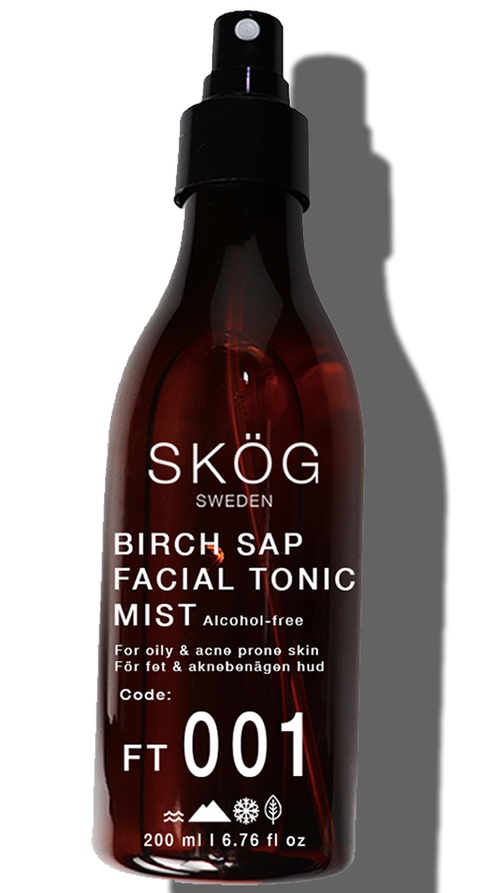
Birch Sap Facial Tonic Mist
Highlights
Skim through
| Ingredient name | what-it-does | irr., com. | ID-Rating |
|---|---|---|---|
| Birch Sap | |||
| **Rose Hydrosol | |||
| **Neroli Hydrosol | |||
| **Witch Hazel Hydrosol | soothing, antimicrobial/antibacterial | ||
| **Aloe Vera | soothing, moisturizer/humectant | goodie | |
| Aqueous Extracts | solvent | ||
| **Grape Seed Oil | antioxidant, emollient | goodie | |
| *Glyceryl Caprylate | preservative | ||
| *Glyceryl Undecylenate | emollient, emulsifying |
SKOG Sweden Birch Sap Facial Tonic MistIngredients explained
The flower water coming from the flowers of the Damask Rose. In general, flower waters (also called hydrosols) are diluted versions of essential oils coming from the same plant. They contain the same components but in much-reduced concentrations.
Similar to its big sister, rose oil, rose water also has a lovely, relaxing scent. It contains some antioxidant and antimicrobial compounds, as well as some fragrant components.
If your skin is super sensitive, it is a good idea to choose products without fragrant floral waters.
This ingredient name is not according to the INCI-standard. :( What, why?!
The distillate created from the leaves of the hazelnut-bush-like-magic-tree commonly called Witch Hazel. The distillate from the leaves is probably the gentlest, most diluted version of any kind of With Hazel ingredient.
The leaves contain much, much less active components than the bark (4.77% vs 0.04% tannins) and distillates are more diluted than extracts. So this one is probably just a "fancy-water" that resembles the properties of Witch Hazel Extract (astringent, soothing, antioxidant, antibacterial) in a very mild and gentle way.
We have gone into much more details about Witch Hazel here.
Aloe Vera is one of today’s magic plants. It does have some very nice properties indeed, though famous dermatologist Leslie Baumann warns us in her book that most of the evidence is anecdotal and the plant might be a bit overhyped.
What research does confirm about Aloe is that it’s a great moisturizer and has several anti-inflammatory (among others contains salicylates, polysaccharides, magnesium lactate and C-glucosyl chromone) as well as some antibacterial components. It also helps wound healing and skin regeneration in general. All in all definitely a goodie.
Good old water, aka H2O. The most common skincare ingredient of all. You can usually find it right in the very first spot of the ingredient list, meaning it’s the biggest thing out of all the stuff that makes up the product.
It’s mainly a solvent for ingredients that do not like to dissolve in oils but rather in water.
Once inside the skin, it hydrates, but not from the outside - putting pure water on the skin (hello long baths!) is drying.
One more thing: the water used in cosmetics is purified and deionized (it means that almost all of the mineral ions inside it is removed). Like this, the products can stay more stable over time.
A goodie plant oil coming from the polyphenol-rich seeds of the grape. It's a light emollient oil that makes your skin feel smooth and nice and also contains a bunch of good-for-the-skin stuff. It's a great source of antioxidant polyphenols, barrier repair fatty acid linoleic acid (about 55-77%, while oleic acid is about 12-27%) and antioxidant, skin-protectant vitamin E.
A 100% plant derived, natural (Ecocert approved) multi-functional ingredient that has emollient and moisturizing properties, can work as a co-emulsifier (meaning that next to other emulsifiers it can help water and oil to mix) and even more importantly has a strong antimicrobial activity.
Thanks to this last thing, it allows a lower percentage of traditional preservative or it might even be able to completely replace them.

You may also want to take a look at...
| what‑it‑does | soothing | antimicrobial/antibacterial |
| what‑it‑does | soothing | moisturizer/humectant |
| what‑it‑does | solvent |
| what‑it‑does | antioxidant | emollient |
| what‑it‑does | preservative |
| what‑it‑does | emollient | emulsifying |





